Getting an education at a good university is essential for a successful career and a high salary. However, the cost of one year of study can reach tens of thousands of dollars, which is why few people can afford it.
Many students try to get student loans to avoid mixing work and study. They do not have as high an interest rate as personal loans, but they are usually only available to students with good credit scores. So what should those with poor credit do? We’ve answered that question in this article and given you a list of financial institutions, not including any payday advance app, where you can borrow money even with a score below 600.
Student Loans For Bad Credit: Best Offers
Many companies in the U.S. financial market specialize in working with borrowers with bad credit. That’s why it won’t be hard for you to find the right one for you.
However, to save time and not consider companies that offer unfavorable terms, we have gathered a list of financial institutions that provide the best bad credit student loans.
In the fall of 2022, the average interest rates for student loans ranged from 6.2% to 14.75% for fixed interest rates and from 4.89% to 13.3% for variable interest rates. You can use these rates as a guide when choosing your lender, so be sure to compare offers and choose the one that works best for you.

Ascent Independent Student Loan
Ascent is a financial institution where you can get a loan at 4.62%-16.06% or 4.14%-13.15%. You will have three loan options:
- Student loan with a co-signer.
The minimum amount of this loan is $2,000, and the maximum is $200,000. It is available for 5 to 15 years if your co-signer score is above 670 and you have an income greater than $24,000 annually. It has a grace period of nine months and three repayment options (deferred payments, interest-only, and $25 payments).
In addition, Ascent offers a 0.25% autopay discount and a 1% cash-back graduation reward for those who graduate within five years of their first loan disbursement date.
- Credit-based student loans.
This option is suitable for those with stable employment, reliable income, and more than two years of credit history. You can get from two to two hundred thousand dollars for 5 to 15 years at an APR of 10.20% to 16.75%.
- Outcomes-based student loans.
If you have a bad credit rating, no stable income, and no co-signer, you can apply for this type of loan. In this case, the lender will look not at your financial situation today but at your prospects. Your eligibility will depend on your school, degree program, GPA, and the cost of attendance.
This option is available only to U.S. students or permanent residents who are full-time college juniors, seniors, and graduate students and will attend one of 2,600 partner schools. It is also the most expensive because it has a fixed interest rate of 13.66% to 14.77%. Note that you can’t repay this loan immediately, but only after you graduate and have a grace period of nine months.
Ascent is generally one of the best lenders for bad or no credit student loans. It offers payment flexibility, rate discounts, a 1% cash-back upon graduation, and other features. But it has two major drawbacks – it does not give loans to students enrolled less than half-time, and it does not allow students without U.S. citizenship or permanent residency to apply with a co-signer.
Federal Subsidized
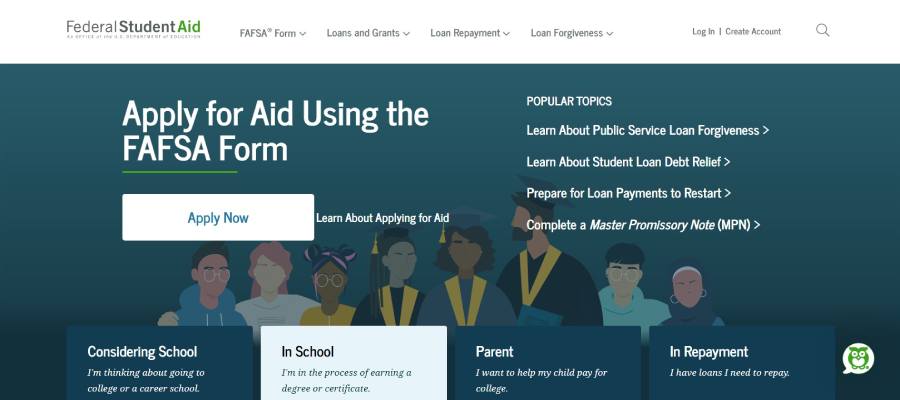
Government-subsidized student loans for bad credit are an excellent option for students with low credit scores because they do not require a credit check. They also have the following advantages:
- Federal student loans have one fixed interest rate (it may only vary depending on the type of loan) that is offered to all students, regardless of their income level, credit rating, or financial situation.
- They also have a lower interest rate.
- If you choose this type of student loan, you can select a repayment plan that works for you. For example, if you can’t make a total monthly payment all at once, you can start with small payments and gradually increase them over time.
At the same time, however, federal student loans are not suitable for everyone because of their disadvantages:
- The maximum amount of this loan is low. For undergraduates, it is up to $9,500 the first year and a maximum of $57,500 over four years of study. This is insufficient to cover the entire cost of attending a private university.
- You can find better interest rates from private lenders if you already have a credit history and a good credit score. For example, federal student loans have an interest rate of 5-7.5%, and some private financial institutions can lend you more at 3%-5%.
- Some of these loans have a high loan fee of 4.2%.
To qualify, you must have satisfactory academic progress, a high school diploma or GED, and a Social Security number. The repayment period can be up to 30 years.
The process of applying for a federal student loan is straightforward. First, you must fill out the Free Application for Federal Student Aid (FAFSA) online and find out which financial aid option is right for you. Then, if satisfied with the terms offered, you can sign the loan agreement.

A.M. Money Private Student Loan
A.M. Money offers federal student loans from $2,001 to $50,000 for ten years at an APR of 7.53%. In addition, this lender has the following advantages:
- You can take out an income-based repayment option if you do not have enough income to pay your monthly payments. In that case, you will give back at most 15% of your income, a minimum of $50.
- You do not need a high credit score or a co-signer for approval. A.M. Money looks at your merits and GPA to determine if you can get a loan.
- A.M. Money has low interest rates compared to other lenders. They are at most 8.85%.
However, this financial institution has some disadvantages that may prevent you from getting a loan here. First, only juniors, seniors, or graduate students from partner colleges, currently only 23, can apply. Most of them are located in Illinois.
In addition, you can only borrow up to $50,000 from this organization, which is less than many private lenders. And it’s essential to remember that A.M. Money charges a 4.5 percent origination fee on all of its loans.
To get this loan, you must go to the lender’s website and fill out a prequalification form (you will need to enter your name, email, and phone number). Then, A.M. Money will suggest options that fit your credit score, and you can sign a loan agreement.
Funding U Private Student Loan
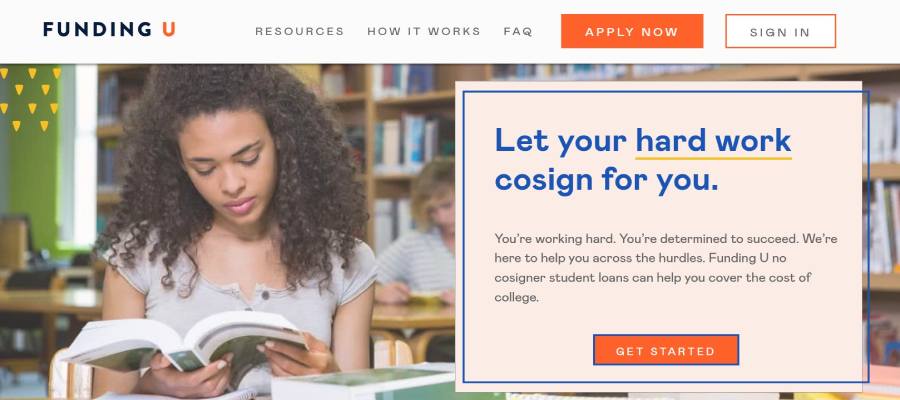
Funding U is one of the most popular lenders that provides loans without a co-signer to undergraduate students. Its main advantage is that it does not look at credit history to make a loan decision, so it is an excellent option for those with a low credit score.
Funding U will look at your GPA and other merit-based factors to determine whether to lend you money. Here you can get up to $20,000 for ten years at an APR of 7.5% to 12.99%.
You can choose between two repayment plans when you sign a loan agreement. You can make either $20 flat or interest-only payments while in school. Also, the company does not charge origination or application fees.
However, it has a few disadvantages: Funding U only operates at $20,000 and has a reasonably high interest rate with a repayment period of only ten years.
Because Funding U can lend a maximum of $20,000, this option is best suited for borrowers looking for a supplemental rather than a significant student loan. However, it is also important to remember that this option only suits those enrolled full-time.
Stride Funding Income Share Agreement
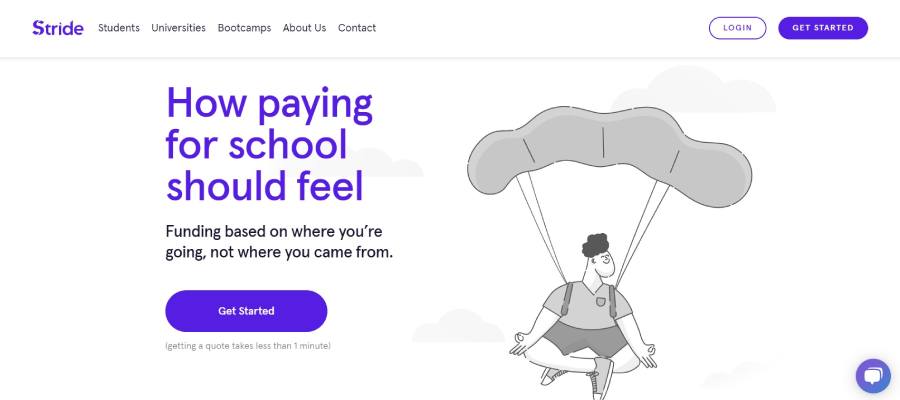
Stride Funding offers loans of up to $25,000 a year to students with low credit score who agree to income-share agreements. The repayment period for such a loan will be from 5 to 10 years, and those who earn at least $30,000 a year can get it.
The advantages of this financial institution are as follows:
- You don’t have a high credit score to get credit here. Instead, Stride will have a portion of your income on estimated future earnings.
- Stride works with many large companies, offering its borrowers networking opportunities and career-boosting workshops.
At the same time, however, this option has its disadvantages. First, you must receive funding within two years of your graduation date. In addition, Stride does not disclose information about its maximum income share rate percentage before you apply, which is very inconvenient. The last disadvantage of the company is the short three-month grace period.
Eligibility requirements for Stride Funding borrowers are as follows:
- You must be a U.S. resident or a permanent resident.
- Have a GPA of at least 2.9.
- Be enrolled at least half the time.
This option is best suited for borrowers studying to become professionals in a high-earning field. You can apply online at the Stride website if you meet all the criteria.
What a Student Loan with Bad Credit Is
Less than one-third of students can pay for college or university in the United States, so many come to lenders for financial aid. Fortunately, the U.S. has long had a type of loan called student loans. Its main difference from personal loans is that lenders work even with borrowers with adverse credit history or low credit score.
If you are over 18, you can get a federal loan or borrow money from a private lender. The second option is usually more advantageous for students in promising professions.
Usually, the price and terms of the loan depend on the academic year the student studied, the cost of tuition, the future profession, the availability of a co-signer, and the student’s financial circumstances. Don’t expect all lenders to want to offer you favorable terms. Unfortunately, students are considered a risky group of borrowers because they have no stable employment, income, or credit history.
What Should You Consider Before Choosing a Student Loan with Bad Credit?
Before applying for a loan from any financial institution, you must prepare. You can follow this plan:
- Calculate how much money you need to cover tuition and possible living expenses.
So you’ll know which lenders you should apply to – the federal or private (the first can provide smaller amounts, but at a better annual interest rate).
- Try to get federal aid for students.
Even if you are sure you want to borrow from a private institution, you can fill out the Free Application for Federal Student Aid (FAFSA) to see if you qualify for any type of federal aid.
- Look at the approximate interest rates and terms for borrowers with your credit score.
Be sure to compare offers from several lenders to choose the best one. Do not settle for the first offer because a student loan is a significant sum you will have to pay back for more than one year.
- Try to find a co-signer.
One of your parents can become your co-signer and help you get better loan terms. If this is the case, you will need to prepare a list of documents to apply for them.
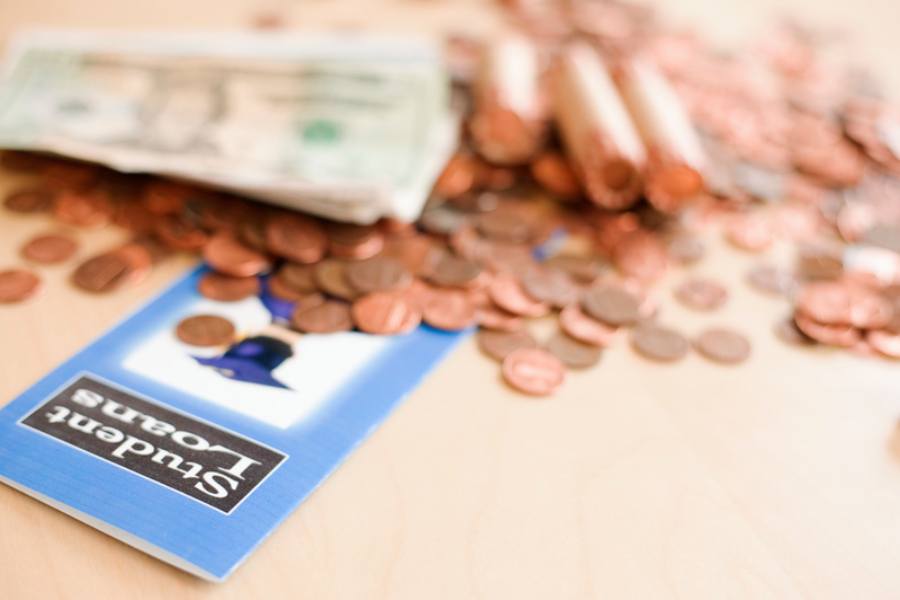
What Credit Score Do I Need For Bad Credit Student Loans?
Typically, private finance companies will only give such loans to students with a credit score greater than 670. However, you can also get a student loan if you have a low credit score. You need to use one of the following options:
- Apply for a federal student loan that does not require a credit score check. You may be able to borrow a smaller amount than a private loan would but at a lower APR.
- You can also turn to private lenders that allow you to get credit with a co-signer. In this case, your credit score does not play a significant role as long as your co-signer scores 670-690 or higher.
So you can get a student loan even with a low credit score.
How Much Do Student Loans for Bad Credit Cost?
The loan price depends on the amount you want to borrow, what academic year you’re currently in, your credit score and income level, and whether you have a co-signer. We’ve compiled average loan data for 2022 and learned that:
- The average student loan is as high as $40,000.
- The average loan repayment period is 20 years.
- The average interest rate of student loans for undergraduates is 5%, and for graduate students, 7%.
The average loan price is $40,000 to $56,000, and the average monthly payment is between $333 and $400. Since some students cannot afford to pay that much each month, they choose alternatives to student loans, which we will discuss below.
Advantages and Disadvantages of Student Loans with Bad Credit
Student loans are often the only way to pay for college or university tuition, the average price of which is $20,770 at public institutions and $47,000 at private ones, which is their main advantage. But they also have several other benefits:
- Student loans often allow Americans to attend the institution of their dreams. For example, if you have a choice between a public university, which you can pay for without a loan, and a private one, which costs more with a student loan, you can choose the second option and study at the place of your dreams.
- You can use this loan to pay not only for tuition but also for living expenses. This is especially important for students who are moving to another city and do not yet have employment or a steady income.
- The earlier you start building your credit history, the easier it will be for you to have a high credit score. If you pay off your student loan on time, you will likely be able to come out of university with a good credit score, enough to qualify for a mortgage or car loan.
However, as you can understand, the disadvantages of this option are also not a few:
- Bad credit student loans credit can be expensive. In the loan’s lifetime, you can pay more than 150% in interest only because it is for 20 years with an interest rate of 5%-15%.
- You start living in debt even before you have a steady income and official employment. This can lead to financial difficulties and problems that will hurt your quality of life.
- If you cannot repay this loan, a record of default on it will remain on your credit report forever. All other negative marks go away after seven years, but there is no program for loan forgiveness or cancellation after seven years for student loans.
You should think carefully before applying for a loan from a financial institution. Just because everyone around you is taking out a student loan to pay for college doesn’t mean it’s the best option for you, too. Be sure to consider the alternatives we’ve outlined below.
How Can You Get a Student Loan with Bad Credit?
Here’s what you have to do to get a student loan with a low credit score:
- Calculate how much you want to borrow.
Remember, the less you borrow, the lower the loan price. You may already have some savings, and you can reduce the loan amount. Or vice versa, you’re about to move to another city and will need money for rent, in which case you can add the approximate cost of living to your desired loan amount.
- Gather information for your application
You will need to provide your personal information, proof of identity, Social Security number, bank account statement, and school information. Note that the FAFSA allows you to enter up to 10 schools on the application, and private financial institutions may ask for specific information about the institution you are going to.
If you are applying with a co-signer, gather information about his credit score, income level, and employment.
- Apply for federal loans
Always start with federal loans with lower interest rates and many benefits.
- If you are not approved for a federal loan or want a larger amount than federal agencies can offer, you may consider private loans.
You can also ask your school if it has a preferred lender list. When choosing, pay attention to the loan term, APR, and any additional fees.
- When you have chosen a loan and are approved for your application, wait until you receive your school certification.
Your school must certify the loan, amend it if necessary, or tell you it is ineligible. After receiving this certification, the lender can make the final disclosure.
What Are Alternatives of Student Loans for Bad Credit?
About 60% of students use loans to pay for their education. What alternatives do the best use?
- Scholarships.
Every college, both public and private, has scholarships for promising and talented students. They pay part or all of the tuition, and may also be for students with financial needs. Most often, you must have a minimum 3.0 GPA to qualify for these scholarships.
- Work-study Programs.
You can check with your college or university to see if they have work-study programs that allow you to get financial aid in exchange for school work. These are usually short-term positions, like summer jobs, that help students earn some money to pay for school.
- Working During School
Studying at a university often allows students to have part-time work. This opportunity offers many benefits, including cheaper health insurance, but it can lead to problems with studying due to lack of time.
Consider working from your second year of university, when you can get a job in your profession. This way, by the time you graduate, you will have practical experience, and it will be easier for you to get a full-time job with a good salary.
- Personal Loans.
Personal loans can be another option for students, but they are more expensive. More often than not, individual loan rates are up to 36%, while bad credit student loans have a maximum APR of up to 15.5%. Usually, this option is used by those who have missed the application period for federal loans.

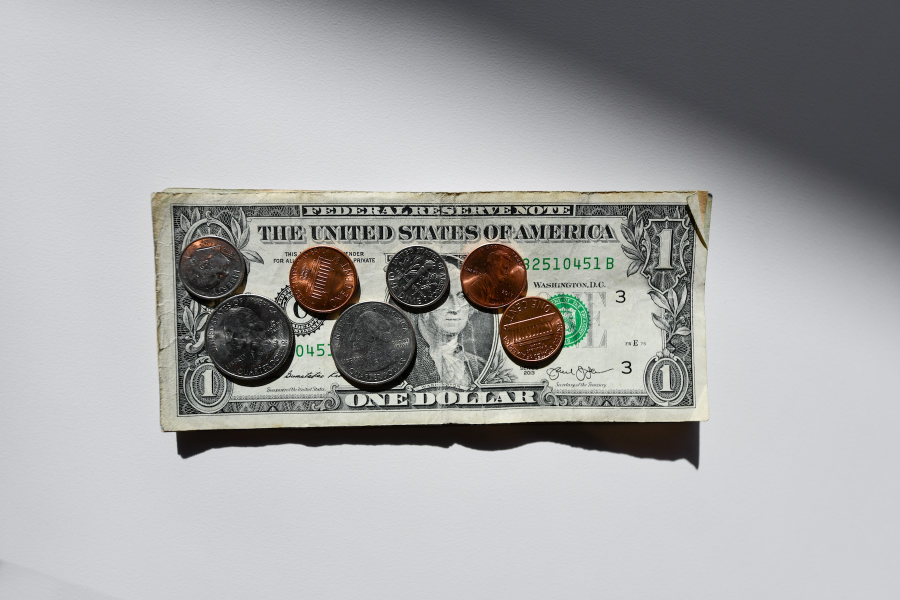
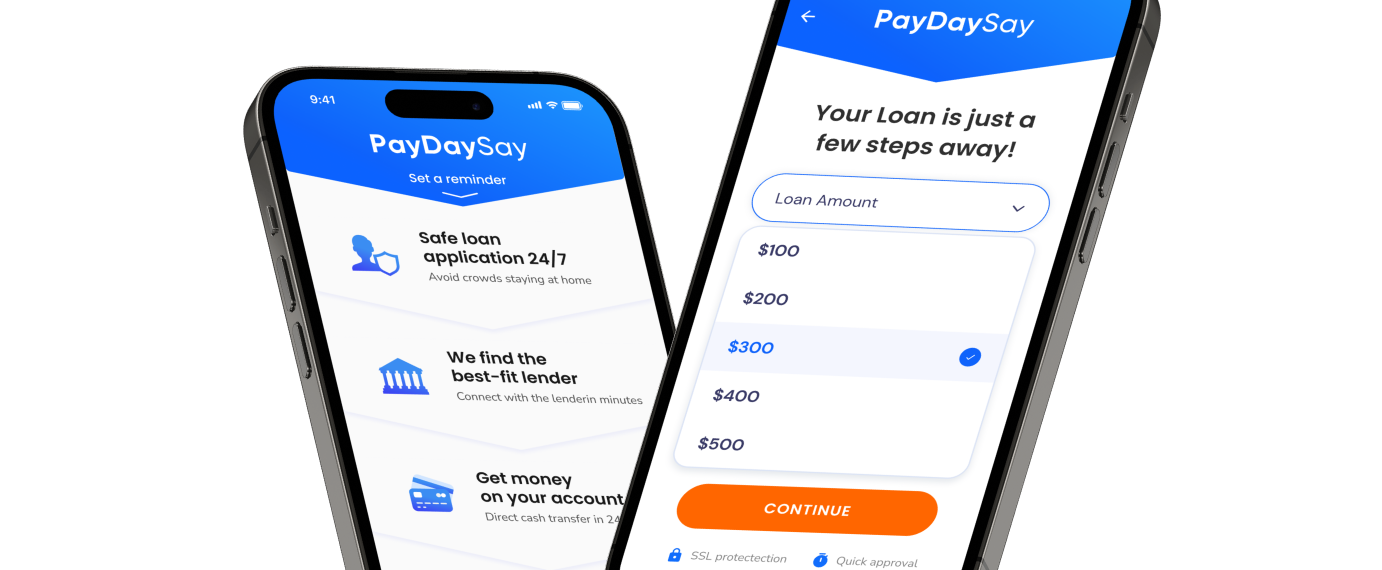










 on your homescreen
on your homescreen
